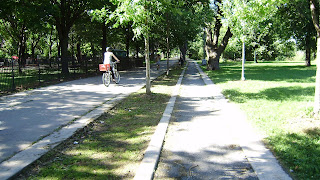
from left: gravel path, asphalt path, concrete walk

note the wide wide curbs on the bike path and jogging path
Before we spend lots of money double-tracking bike and pedestrian paths, it is important to know if double tracking is warranted and if it works where tried elsewhere. I am not opposed to double paths, but I want to know that the expenditure would be worth it, both for the paths and compared to alternative uses of the money.
-
-
Pictured are two views of the same path in Toronto. Click to enlarge. There are actually three paths here: a concrete sidewalk, about 5' wide; an asphalt path about 8' wide, and a gravel path about 3' wide. The gravel path is separated from the other paths by a boulevard of grass and sometimes trees.
-
We walked on the asphalt part. Cyclists rode on the asphalt part, or the gravel part. Runners ran on the asphalt or gravel. No one favoured the concrete squares. This is based on only 15 minutes observation:
1. no signage indicated which path was for which user
2. every type of user used every type of path
3. it did not reduce conflict except by diluting traffic over a broader range of path
4. no self selection of path type was apparent except everyone avoided the concrete path
-
I was really puzzled by the obvious expense of installing really wide curbs along the asphalt and gravel paths. The curbs, flush with the surface, were twice as wide as regular roadside curbs that corral traffic and buses, and about a foot deep. Why were they so big, and why were they there at all? Surely 2"x8"deep precast concrete curb pieces would have done just as well.



I don't think it's a good idea. I think a larger sidewalk would be more effective, like the ones I saw in Ibiza.
ReplyDeleteStrange that there was no signage, something simple like this would make things a lot more clear http://www.mississaugacycling.ca/wp-content/uploads/sign-bike_pedestrian_vancouver.gif
ReplyDelete